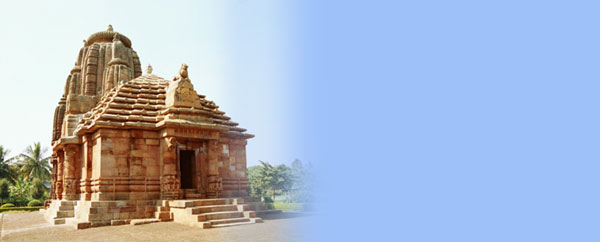Rajarani Temple (Orissa)
The Orissa king who created this temple died
before the finishing touches to the temple were
given.
Rajarani Temple (Orissa) Hindu Temples

The Rajarani temple is an elegant
example of great finesse in temple art architecture. The temple,
dating back to the eleventh century, is set in open paddy fields,
and the entire structure exudes grace and elegance. The name of
the temple has been the subject of much debate. The most likely
explanation is that the name is related to the lovely red-and- gold
sandstone used in its construction, a stone which is known locally
as rajarani. The debate is complicated by the fact that the names
of all the Hindu temples in Bhubaneswar dedicated to the God Shiva
end in the suffix eswar (for example Parasurameswara, Mukteswara,
etc.), while those of the non-Shaivite temples are derived from
their presiding deities (e.g. Parvati temple).One major scholar
has argued that the name Rajarani was only applied to the temple
at a later date (because of the sandstone), and that originally
this is the Shiva shrine referred to in early texts as Indreswara.
This seems the most likely conclusion.
This temple is located in old Bhubaneshwar. This gracefully proportionate
11th country temple stands against the backdrop of green paddy (rice)
fields, looking very alluring. This temple is famous for its elaborately
ornate sanctuary. Here one can see a pair of satries or dikpals
(temple guardians). In addition to these one can see beautiful nymphs,
embracing coupler, lions, elephants decorating the pillars and walls.
Yama in various forms and postures can be seen-it is both fascinating
and intermidating for e.g.: Yama holding several heads and a sword
over the lying figure of a dead man.
The Orissa king who created this temple died before the finishing
touches to the temple were given. A deity was placed leaving the
1 sanctum sanctorum eternally godless, yet it is filled with vacant
peace as no pujas are performed here and one can roam around freely.
The jagmohana (porch) is extremely plain, and was evidently repaired
in 1903 after having fallen down in ruins. The deul (tower), on
the other hand, is spectacularly ornate, and is famous for the aesthetic
concept of miniature temple spires clustered around the main tower.
The sculptural images of the temple are elegant and lively, especially
the beautiful female figures which can be seen in amorous dalliance,
as well as engaged in such activities as holding children, looking
in mirrors, and playing with pet birds. On the lower register of
the deul, on the corner projections, are found the famous 'Guardians
of the Eight Directions', watching over (and radiating the temple's
power to) the eight cardinal points. Beginning from the left of
the entrance to the deul and proceeding in a clockwise direction,
they are: Indra (east, chief of the 33 Vedic nature deities); Agni
(south-east, Vedic God of fire); Yama (south, God of death); Nirriti
(south-west, deity related to suffering); Varuna (west, a Vedic
deity of the ocean); Vayu (north-west, wind God); Kubera (north,
lord of wealth, shown here with a wish-fulfilling tree); and Ishana
(north-east, a form of Shiva).
Location
This temple is located in old Bhubaneshwar.
How To Get There
Air: There are regular Indian Airlines flights to Hyderabad,
Nagpur, Calcutta, Delhi, Varanasi, Bombay and Madras. The airport
is very close to town. If you have an early morning flight, it is
a good idea to have your hotel arrange a taxi the night before and
pay a little more to avoid the morning inconvenience of finding
a taxi at that time. The Indian Airline office is on Raj Path, by
the bus stand.
Rail: Bhubaneswar is on the main Calcutta to Madras line
so all the main trains stop here. The Howrah-Bangalore mail and
Guwahati-Bangalore go to Bangalore. The Coromandel Express is a
good train going to Madras. There are direct trains to Delhi, Agra,
Remuna, and Varanasi. The Rajdhani Express departs from Delhi one
day a week on Friday to Bhubaneswar. The Puri-New Delhi Express
is a good train to Delhi.
Road: The best way to get from Bhubaneswar to Puri is on
one of the Canter minibuses that leave from the old bus station
in the center of town, the new bus stand, and from the petrol station
opposite the Ashok Hotel. They take a little more than an hour to
get to Puri. There are also larger buses that go Puri, but they
are slower than the minibuses. It is best to get an Express bus
to Puri, which make only one stop en route. There is a direct bus
to Konark too. If one misses out the direct bus, one can take a
Puri buses to Pipli and from there get another bus to Konark.
Most of the long-distance buses depart from the new bus stand (Baramunda
Bus Stand), which is about 5-km from downtown on the main road to
Calcutta. There are buses to Calcutta, Cuttack (10 hr), and other
places in Orissa . Buses to Puri also leave from this station.
Other links
Hindu Temples in India
temples
Orissa